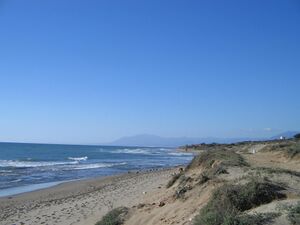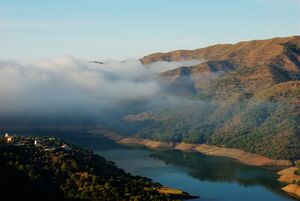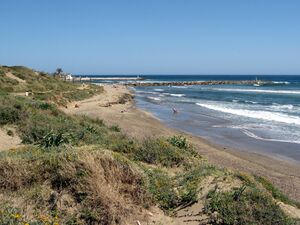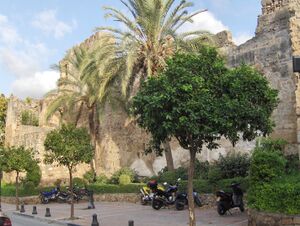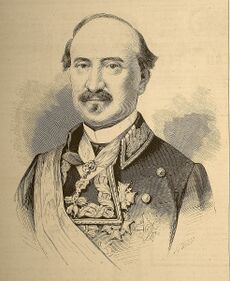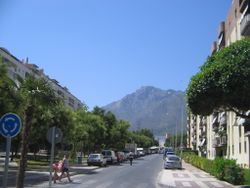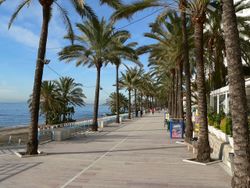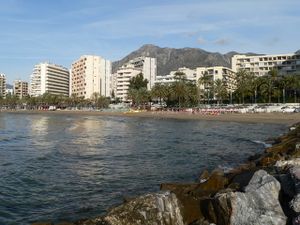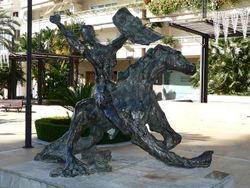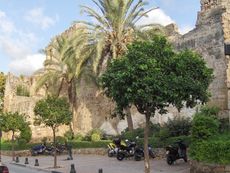ماربيا
ماربيا
Marbella | |
|---|---|
بلدية | |
من اليسار إلى اليمين ومن أعلى إلى أسفل: منظر بانورامي لـ پورتو بانوس، اليخوت الراسية، القلعة القديمة في البلدة القديمة، المساكن الحديثة، برج كنيسة التجسد ، مبنى البلدية في پلازا دي لوس نارانخوس، ملعب للجولف ، الجدار الحضري ومنظر بانورامي من الجبال. | |
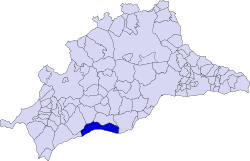 موقع بلدية ماربيا | |
| الإحداثيات: 36°31′0″N 4°53′0″W / 36.51667°N 4.88333°W | |
| البلد | |
| Autonomous community | |
| المقاطعة | مالقة |
| Comarca | Costa del Sol Occidental |
| الحكومة | |
| • النوع | Mayor-council |
| • الكيان | Ayuntamiento de Marbella |
| • العمدة | María Ángeles Muñoz Uriol (PP) |
| المساحة | |
| • الإجمالي | 114٫3 كم² (44٫1 ميل²) |
| • البر | 114٫3 كم² (44٫1 ميل²) |
| • الماء | 0٫00 كم² (0�00 ميل²) |
| التعداد (2006) | |
| • الإجمالي | 124٬332 |
| • الكثافة | 1٬088/km2 (2٬820/sq mi) |
| منطقة التوقيت | UTC+1 (CET) |
| • الصيف (التوقيت الصيفي) | UTC+2 (CEST) |
| الموقع الإلكتروني | www.marbella.es |
ماربيا أو (بالإسبانية:Marbella ؛ UK: /mɑːrˈbeɪjə/ mar-BAY-yə,[1][2] US: /mɑːrˈbɛlə/ mar-BEL-ə,[3] النطق الإسپاني: [maɾˈβeʎa]) هي مدينة تقع في مقاطعة مالقة في جنوب شرق إسبانيا مطلة على البحر المتوسط. يبلغ عدد سكانها حوالي 120,000 نسمة. تشتهر بكونها مدينة سياحية مهمة. It is part of the Costa del Sol and is the headquarters of the Association of Municipalities of the region; it is also the head of the judicial district that bears its name.
Marbella is situated on the Mediterranean Sea, between Málaga and the Strait of Gibraltar, in the foothills of the Sierra Blanca. The municipality covers an area of 117 متر كيلومربع (45 sq mi) crossed by highways on the coast, which are its main entrances.
In 2018 the population of the city was 141,463 inhabitants,[4] making it the second most populous municipality in the province of Málaga and the eighth in Andalusia. It is one of the most important tourist cities of the Costa del Sol and throughout most of the year is an international tourist attraction, due mainly to its climate and tourist infrastructure.
The city also has a significant archaeological heritage,[5] several museums[6][7] and performance spaces,[8] and a cultural calendar[9] with events ranging from reggae concerts[10] to opera performances.[11]
الجغرافيا
The Marbella municipality occupies a strip of land that extends along أربعة وأربعون كيلومتر (27 ميل) of coastline of the Penibético region, sheltered by the slopes of the coastal mountain range, which includes the Bermeja, Palmitera, Royal, White and Alpujata sub-ranges. Due to the proximity of the mountains to the coast, the city has a large gap between its north and south sides, thus providing views of the sea and mountain vistas from almost every part of the city. The coastline is heavily urbanised; most of the land not built up with golf courses has been developed with small residential areas. Marbella is bordered on the north by the municipalities of Istán and Ojén, on the northwest by Benahavís, on the west by Estepona and on the northeast by Mijas. The Mediterranean Sea lies to the south.
الطبوغرافيا
There are five geomorphological units: the سييرا بيانكا, the Sierra Blanca piedmont (foothills), the lower hill country, the plains and the coastal dunes.[12] The Sierra Blanca is most centrally located in the province, looming over the old village. This mountain range has three peaks: La Concha, located further west at 1،215 m (3،986 أقدام) above sea level, Juanar Cross, located eastward (within the municipality of Ojen) at 1،178 m (3،865 أقدام) above sea level, and the highest, Mount Lastonar, located between the two at 1،270 m (4،170 أقدام). Marbella's topography is characterised by extensive coastal plains formed from eroded mountains.[13] North of the plain, is an area of elevations from 100 و 400 m (330 و 1،300 أقدام), occupied by low hills, with foothills and steeper slopes of the mountains behind. The coast is generally low and has sandy beaches that are more extensive further east, between the fishing port and Cabopino. Despite the intense urbanisation of the coast, it still retains a natural area of dunes, the Artola Dunes (Dunas de Artola), at the eastern end of town.
المياه العذبة
The entire region lies within the Andalusian Mediterranean Basin. The rivers are short and have very steep banks, so that flash floods are common.[14] These include the Guadalmina, the Guadaiza, the Verde and the Rio Real, which provide most of the water supply. The irregularity of rainfall has resulted in intermittent rivers that often run dry in summer; most of the many streams that cross the city have been bridged. The La Concepción reservoir supplies the population with drinking water; apart from this there are other reservoirs like El Viejo and El Nuevo (the Old and the New) that irrigated the old agricultural colony of El Ángel, and Las Medranas and Llano de la Leche that watered the plantations of the colony of San Pedro de Alcántara.
المناخ
Marbella has a subtropical Mediterranean climate[15] (Köppen: Csa) with humid, very mild winters (for European standards) and warm to hot, dry summers. Marbella is protected on its northern side by the coastal mountains of the Cordillera Penibética and so enjoys a climate with an average annual temperature between 18 إلى 19 °C (64 إلى 66 °F). During winters, the highest peaks of the nearby mountain range are occasionally covered with snow, which can be seen from the coastline of Marbella when it snows on the Sierra Blanca mountain peak at 1،275 m (4،183 ft).[16][17] Average rainfall is 645.8 mm (25.43 in), while hours of sunshine average above 2,900 annually.[18]
| بيانات المناخ لـ ماربيا، 1981–2010 | |||||||||||||
|---|---|---|---|---|---|---|---|---|---|---|---|---|---|
| الشهر | ينا | فب | مار | أبر | ماي | يون | يول | أغس | سبت | أكت | نوف | ديس | السنة |
| متوسط القصوى اليومية °س (°ف) | 16.4 (61.5) |
16.9 (62.4) |
18.4 (65.1) |
19.8 (67.6) |
22.2 (72.0) |
24.8 (76.6) |
26.9 (80.4) |
27.3 (81.1) |
25.5 (77.9) |
22.6 (72.7) |
19.5 (67.1) |
17.3 (63.1) |
21.5 (70.6) |
| المتوسط اليومي °س (°ف) | 12.9 (55.2) |
13.5 (56.3) |
15.0 (59.0) |
16.4 (61.5) |
18.7 (65.7) |
21.5 (70.7) |
23.6 (74.5) |
24.0 (75.2) |
22.2 (72.0) |
19.4 (66.9) |
16.2 (61.2) |
14.0 (57.2) |
18.1 (64.6) |
| متوسط الدنيا اليومية °س (°ف) | 9.4 (48.9) |
10.0 (50.0) |
11.6 (52.9) |
12.9 (55.2) |
15.1 (59.2) |
18.2 (64.8) |
20.3 (68.5) |
20.6 (69.1) |
18.9 (66.0) |
16.2 (61.2) |
12.9 (55.2) |
10.7 (51.3) |
14.7 (58.5) |
| متوسط تساقط الأمطار mm (inches) | 88.8 (3.50) |
75.8 (2.98) |
57.3 (2.26) |
50.8 (2.00) |
25.2 (0.99) |
5.7 (0.22) |
1.1 (0.04) |
5.8 (0.23) |
29.9 (1.18) |
64.6 (2.54) |
108.8 (4.28) |
132.0 (5.20) |
645.8 (25.42) |
| Average precipitation days (≥ 1 mm) | 7.3 | 6.7 | 5.7 | 6.2 | 4.4 | 0.9 | 0.4 | 0.4 | 2.7 | 5.7 | 7.0 | 8.8 | 56.2 |
| Source: World Meteorological Organization (WMO)[19] | |||||||||||||
النبيت والوحيش
Because most of the mountain areas around Marbella cannot be managed by the City Council and they are under the management of the central government, remnants of the land in its natural state are still preserved in the mountains, where there are chestnut and cherry trees; reforested firs; Aleppo, Monterrey and maritime pines, pinyons; and ferns. The fauna is represented by golden eagles, Bonelli's eagles, short-toed eagles, hawks, falcons, vultures, genets or musk cats, badgers, wild goats, deer, martens, foxes and rabbits.[20]
The coast has the Natural Monument site of the Dunas de Artola, one of the few protected natural beaches of the Costa del Sol, which contains marram grass, sea holly, sea daffodils and shrubs such as large-fruited juniper.[21] The Posidonia oceanica, endemic to the Mediterranean, is found in the Cabopino area; it is an important part of the ecosystem in the sea around Marbella.[22]
السكان
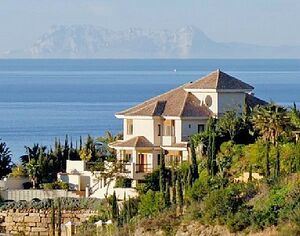
According to the census of the INE for 2018, Marbella had a population of 141,463 inhabitants,[23] which ranked it as the second-most populous city in the province of Málaga and eighth in Andalusia after surpassing Cádiz in 2008.[24][25] Unlike other towns in the Costa del Sol, Marbella had a significant population before the population explosion caused by the tourist boom of the 1960s. The census counted about 10,000 people in 1950; population growth since has been as great as that of neighboring towns. Between 1950 and 2001 the population grew by 897%, with the decade of the 1960s having the highest relative increase, at 141%. In 2001, only 26.2% of Marbella's population had been born there, 15.9% were foreign-born, and those born in other towns in Spain made up the difference. During the summer months the population of Marbella increases by 30% with the arrival of tourists and foreigners who have their second homes in the area.[26]
The population is concentrated in two main centres: Marbella and San Pedro Alcántara; the rest is scattered in many developments in the districts of Nueva Andalucia and Las Chapas, located along the coast and on the mountain slopes. According to a study by the Association of Municipalities of the Costa del Sol, based on the production of solid waste in 2003, Marbella had a population of about 246,000 inhabitants, almost twice that of the population census of 2008. From the estimated volume of municipal waste in 2010, the City calculates the population during the summer months at around 400,000 people, while official police sources estimated it at about 500,000, with a peak of up to 700,000 people.[بحاجة لمصدر]
Demonyms
Traditionally the people of Marbella have been called "marbelleros" in the local vernacular and "marbellenses" in more formal registers; these names have appeared in dictionaries and encyclopedias.[27] Since the mid-1950s, however, Marbellan residents have been called "marbellís" or "marbellíes", the only gentilic, or demonym, that appears in the Diccionario de la Lengua Española (Dictionary of the Spanish Language) published by the Royal Spanish Academy.[28]
The use of "marbellí" as a gentilic was popularised by the writer and journalist Víctor de la Serna (1896–1958), who wrote a series of documentary articles on "The Navy of Andalucía"; in his research he had come upon the Historia de Málaga y Su Provincia (History of Málaga and the Province) by Francisco Guillén Robles, who used the plural word "marbellíes" to designate the Muslim inhabitants of Marbella.[29]
التاريخ
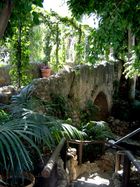
Prehistory and antiquity
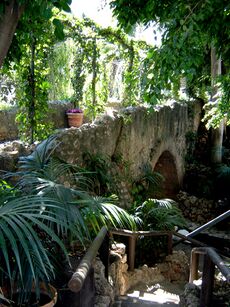
Archaeological excavations have been made in the mountains around Marbella which point to human habitation in Paleolithic and Neolithic times. Some historians believe that the first settlement on the present site of Marbella was founded by the Phoenicians in the 7th century BC, as they are known to have established several colonies on the coast of Málaga province. However, no remains have been found of any significant settlement, although some artefacts of Phoenician and later Carthaginian settlements have been unearthed in different parts of the municipality, as in the fields of Rio Real and Cerro Torrón.[30]
The existence of a Roman population centre in what is now the El Casco Antiguo (Old Town) is suggested by three Ionic capitals embedded in one section of the Murallas del Castillo (Moorish castle walls), the reused materials of a building from earlier times. Recent discoveries in La Calle Escuelas (School Street) and other remains scattered throughout the old town testify to a Roman occupation as well. West of the city, on the grounds of the Hotel Puente Romano, is a small 1st century Roman Bridge over a stream.[31] There are ruins of other Roman settlements along the Verde and Guadalmina rivers: Villa Romana on the Rio Verde (Green River), the Roman baths at Guadalmina, and the ruins of a Roman villa and an early Byzantine basilica at Vega del Mar, built in the 3rd century and surrounded by a paleo-Christian necropolis, later used as a burial ground by the Visigoths. All of these further demonstrate a continued human presence in the area. In Roman times, the city was called Salduba (Salt City).[32]
Middle Ages
During the period of Islamic rule, after the Normans lay waste to the coast of Málaga in the 10th century, the Caliphate of Córdoba fortified the coastline and built a string of several lighthouse towers along it. In the Umayyad fashion[33] they constructed a citadel, the Alcazaba, and a wall to protect the town,[34] which was made up of narrow streets and small buildings with large patios, the most notable buildings being the citadel and the mosque. The village was surrounded by orchards; its most notable crops were figs and mulberry trees for silkworm cultivation. The current name most likely developed from the name the Arabs gave it: Marbal·la (مربلة),[35] which may in turn derive, according to some linguistic investigations, from a previous Iberian place name. The traveller Ibn Battuta characterised it as "a pretty little town in a fertile district."[36][37] During the time of the first kingdoms of Taifa, Marbil-la was disputed by the Taifas of Algeciras and of Málaga, eventually falling into the orbit of Málaga, which in turn later became part of the Nazarid Kingdom. In 1283 the Marinid sultan Abu Yusuf Yaqub ibn Abd Al-Haqq launched a campaign against the Kingdom of Granada. Peace between the Marinid dynasty and the Nasrid dynasty was achieved with the signing of the Treaty of Marbella on 6 May 1286, by which all the Marinid possessions in Al-Andalus were restored to the Nazarid sultan.[38]
Early modern age
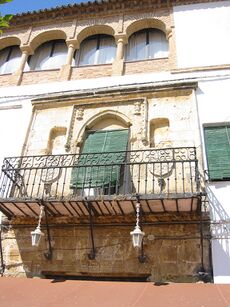
On 11 June 1485, the town passed into the hands of the Crown of Castile without bloodshed. The Catholic Monarchs gave Marbella the title of city and capital of the region and made it a realengo (royal protectorate). The Plaza de los Naranjos was built along the lines of Castilian urban design about this time, as well as some of the historical buildings that surround it. The Fuerte de San Luis de Marbella (Fort of San Luis) was built in 1554 by Charles V. The main door faced north and was protected by a moat with a drawbridge. Today, the ruins of the fort house a museum, and on the grounds are the Iglesia del Santo Cristo de la Vera Cruz (Church of the Holy Christ of the True Cross) and Ermita del Calvario (Calvary Chapel). Sugar cane was introduced to Marbella in 1644, the cultivation of which spread on the Málaga province coast,[39] resulting in the construction of numerous sugar mills, such as Trapiche del Prado de Marbella.
19th century
In 1828 Málaga businessman Manuel Agustín Heredia founded a company called La Concepción[40] to mine the magnetite iron ores[41] of the Sierra Blanca at nearby Ojén, due to the availability of charcoal made from the trees of the mountain slopes and water from the Verde River, as a ready supply of both was needed for the manufacture of iron. In 1832 the company built the first charcoal-fired blast furnace for non-military use in Spain;[42] these iron-smelting operations ultimately produced up to 75% of the country's cast iron. By 1860 competition from the coke-fired blast furnaces in northern Spain had made the plant uneconomical. In 1860 the 1st Marquess of Duero founded an agricultural colony for the unemployed iron workers, now the heart of San Pedro de Alcántara.[43]
The simultaneous dismantling of the iron industry, based in the forges of El Angel and La Concepción, disrupted the local economy. Much of the population had to return to farming or fishing for a livelihood. The situation was compounded by the widespread crisis of traditional agriculture and by the epidemic of phylloxera blight in the vineyards,[44] causing Marbella to suffer high unemployment, an increase in poverty, and the starvation of many day labourers.
The associated infrastructure built for the installation of the foundry of El Angel in 1871 by the British-owned Marbella Iron Ore Company[45] temporarily relieved the situation, and even made the city a destination for immigrants, increasing its population. However, the company did not survive the worldwide economic crisis of 1893, and closed its doors in that year due to the difficulty of finding a market for the magnetite iron ore it mined.[46]
In the late 19th century, Marbella was a village composed of three parts: the main districts, the Barrio Alto or San Francisco, and the Barrio Nuevo. There were three smaller nuclei arranged around the old ironworks and the farm-model of the colony of San Pedro Alcántara, as well as isolated dwellings in orchards and farms. The general population was divided between a small group of oligarchs and the working people, the middle class being practically non-existent.
20th century
In the early decades of the century the first hotels were built: El Comercial, which opened in 1918, and the Miramar, in 1926.[47] During the Second Republic, Marbella experienced major social changes and contentious political parties mobilized.
As the Spanish Civil War began in the late 1930s, Marbella and Casare suffered more anticlerical violence than the rest of western Málaga province. The day after the failed uprising which led to the civil war, several religious buildings in Marbella were set on fire. Only the walls of the Church of St. Mary of the Incarnation and the Church of San Pedro Alcantara were left standing.[48] With the aid of Fascist Italian troops, Nationalist forces seized Marbella during the first months of the war. It became a haven for prominent Nazis, including Léon Degrelle and Wolfgang Jugler, and Falangist personalities like José Antonio Girón de Velasco[49] and José Banús.[50]
After the Second World War, Marbella was a small jasmine-lined village with only 900 inhabitants. Ricardo Soriano, Marquis of Ivanrey, moved to Marbella and popularised it among his rich and famous friends.[51] In 1943, he acquired a country estate located between Marbella and San Pedro called El Rodeo, and later built a resort there called Venta y Albergues El Rodeo, beginning the development of tourism in Marbella.[52]
Soriano's nephew, Prince Alfonso of Hohenlohe-Langenburg, descendant of a high-ranking aristocratic family (his mother, María de la Piedad de Yturbe y Scholtz-Hersmendorff, was the Marquesa de Belvís de las Navas) acquired another estate, Finca Santa Margarita. In 1954, he opened the Marbella Club, an international resort aimed at movie stars, business executives and the nobility.
Both resorts came to be frequented by members of European aristocratic families with famous names: Bismarck, Rothschild, Thurn und Taxis, Metternich, de Mora y Aragon, de Salamanca or Thyssen-Bornemisza. This transformed Marbella into a destination for the international jet set.[51] Trading on Prince Alfonso's kinship to the royal courts of Europe, his hotel quickly proved popular with vacationing members of Europe's social elites, for its casual but discreet luxury. Jaime de Mora y Aragón, a Spanish bon vivant and brother to Fabiola, Queen of the Belgians, as well as Adnan Khashoggi, were frequent visitors.[53][54] Prince Alfonso's first marriage was to Princess Ira von Fürstenberg, an Agnelli heiress. Princess Marie-Louise of Prussia (great-granddaughter of Kaiser Wilhelm II) and her husband Count Rudolf "Rudi" von Schönburg–Glauchau eventually worked closely with the new proprietors, the Shamoon family, who took over the Marbella Club Hotel from Prince Alfonso.[55]
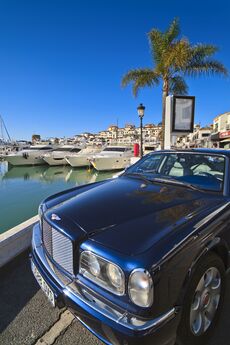
In 1966, Prince Alfonso hired a Beverly Hills architect and, with the assistance of the Banus family, who were personal friends of dictator Francisco Franco and had already developed the later-controversial Valle de los Caídos, developed the high-end tourist resort Puerto Banus. The resort opened to much fanfare in 1970. Celebrities in attendance included Franco's designated successor, Juan Carlos (then Prince of Asturias), Prince Rainier of Monaco and his wife Grace Kelly, and Aga Khan IV; entertainers included Julio Iglesias. In 1973, exiled dictator Fulgencio Batista y Zaldívar, who had left Cuba with a fortune estimated at between $100 and $300 million and lived extravagantly in various Iberian resorts, died of a heart attack there.[بحاجة لمصدر] Fugitive financier Marc Rich bought a house in Marbella, renounced his American citizenship and claimed Spanish citizenship during his decades of evading American income taxes,[56] although he spent more time in Switzerland, where he died.
In 1974, Prince Fahd arrived in Marbella from Monte Carlo.[57] Until his death in 2005, Prince Fahd was a frequent and profligate guest. Marbella welcomed his retinue of over a thousand people spending petro-dollars.[58] The then-anonymous Osama bin Laden visited on a number of occasions with his family between 1977 and 1988.[59]
In the 1980s, Marbella continued as a popular jet set destination. However, the 1987 kidnapping of Melodie Nakachian, the daughter of local billionaire philanthropist Raymond Nakachian and the Korean singer Kimera, focused less-favourable international media scrutiny on Marbella, even though a police raid ultimately freed her.[60]
From the first democratic elections after the adoption of the 1978 Spanish Constitution, until 1991, all the mayors of Marbella were members of the Spanish Socialist Workers Party ('El Partido Socialista Obrero Español' or PSOE in Spanish).[61]
In 1991, the builder and president of Atlético Madrid, Jesús Gil was elected mayor of Marbella by a wide majority. He and his party, the right-wing populist Independent Liberal Group ('Grupo Independiente Liberal' or GIL in Spanish), promised to fight petty crime as well as the region's declining prestige. Actor Sean Connery became Marbella's international spokesman, although Connery later ended this business relationship after Gil used his image in an election campaign. Gil's administration facilitated a building boom. However, critics complained about disregard for the existing urban plan, market speculation and environmental predation by developers; the regional Andalusian government suspended some development. Gil despised town-hall formalities, instead ruling from his office at the Club Financiero, and cultivated a maverick image. The PSOE and the People's Party criticized Gil even at the national level, but voters re-elected him and some Spanish celebrities continued to spend summers there. Gil's political party, GIL, also proved popular in other tourist-dependent Costa del Sol towns like Estepona, and even across the Strait of Gibraltar to the Spanish North African cities of Ceuta and Melilla.
In 1999, Gil was convicted of embezzling public funds and falsifying public documents.[62] Gil died in 2004, and his party remained in power until 2006, but related scandals continue to this day, as discussed below.
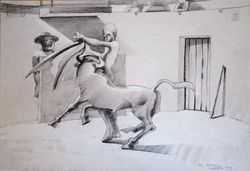
أهم المعالم في ماربيا وحولها
- Olivia Valere (Upscale restaurant, bar and disco)
- السور العربي
- متحف بونساي
- Museo del Grabado Español Contemporáneo
- Old city centre
- Playa de la Bajadilla (beach)
- Playa de Fontanilla (beach)
- Bernadette exposed in public
- Puerto Banús, a marina built by José Banús where Rolls-Royces and Ferraris meet yachts.
- The Golden Mile featuring the Marbella Club Hotel and its beach club, وكذلك قصر الملك فهد الراحل.
- Encarnation's Church (Iglesia de la Encarnación) Oldest church in the city placed in the old-town
مشاهير المقيمين
- Arthur Rubinstein, concert pianist, purchased a house in Marbella in the 1950's. In the 1957 academy award winning documentary film, "Arthur Rubinstein, The Love of Life," the footage of Rubinstein at home was filmed at his Marbella, Spain house,
- Sean Connery had a residence in Marbella from 1970 to 1998, where he was regularly seen playing golf when not filming.[63]
- Jean Negulesco, Romanian-American film director and screenwriter, lived in Marbella from the late 1960s until his death on 18 July 1993 at age 93.
- George Clooney, actor
- Novak Djokovic
- Jon Olsson
- Rick Parfitt OBE, British rock musician from Status Quo, lived in the mountains just outside Marbella.[64]
- Antonio Banderas, born in the nearby city of Málaga, has been a regular visitor to Marbella where he has a house in Los Monteros. Stella, his daughter with wife actress Melanie Griffith, was born in Marbella in 1999.
- Arms dealer Monzer al-Kassar was a longtime resident until his imprisonment, and has been nicknamed "The Prince of Marbella".
- Mike Reid, English actor and comedian, was living in Marbella at the time of his death on 29 July 2007. He was born in Hackney, London, and retired to Marbella a few years before he died.
- Millie Bobby Brown, English actress and Eleven in Stranger Things was born in Marbella on 19 February 2004.[65]
- Ráhel Orbán, eldest daughter of Hungarian prime minister Viktor Orbán, moved with her family to Marbella in September 2021.[66]
البلدات التوأم – المدن الشقيقة
Marbella is twinned with:[67][68][69]
 Baler, Aurora, Philippines
Baler, Aurora, Philippines Batumi, Autonomous Republic of Adjara, Georgia
Batumi, Autonomous Republic of Adjara, Georgia Doha, Qatar
Doha, Qatar Itanhaém, São Paulo, Brazil
Itanhaém, São Paulo, Brazil Jeddah, Hejaz, Saudi Arabia
Jeddah, Hejaz, Saudi Arabia Kure, Hiroshima, Japan
Kure, Hiroshima, Japan Miami Beach, Florida, United States
Miami Beach, Florida, United States Nabeul, Cape Bon, Tunisia
Nabeul, Cape Bon, Tunisia Punta del Este, Maldonado Department, Uruguay
Punta del Este, Maldonado Department, Uruguay Solidaridad, Quintana Roo, Mexico
Solidaridad, Quintana Roo, Mexico
See also
الهامش
- ^ "Marbella". Collins English Dictionary. HarperCollins. Retrieved 16 July 2019.
- ^ "Marbella". Lexico UK English Dictionary. Oxford University Press. Archived from the original on 2020-03-22.
- ^ "Marbella". The American Heritage Dictionary of the English Language (5th ed.). HarperCollins. Retrieved 16 July 2019.
- ^ La población andaluza. Instituto de Estadística y Cartografía de Andalucía. 2011. Retrieved 28 January 2013.
- ^ "Archaeology Marbella". PGB España. Archived from the original on 29 June 2012. Retrieved 14 April 2013.
- ^ "Marbella Museums and Art Galleries". World Guides. Archived from the original on 28 January 2013. Retrieved 14 April 2013.
- ^ "An up-and-coming cultural quarter for Marbella?". Déjà Vu Marbella. 19 November 2012. Archived from the original on 15 June 2013. Retrieved 14 April 2013.
- ^ "Costa del Sol Concerts for Summer 2012". i-Marbella.com. Archived from the original on 11 July 2012. Retrieved 14 April 2013.
- ^ "Marbella events and activities". Marbella Family Fun. Archived from the original on 29 January 2013. Retrieved 14 April 2013.
- ^ "Reggaeville: World of Reggae in One Village". Reggaeville.
- ^ "Marbella Opera Festival & Other August Events". Enforex Spanish Language School. Archived from the original on 8 August 2009. Retrieved 13 April 2013.
- ^ Marbella: mapa geológico de España. Ministerio de Industria y Energía. 1978. Retrieved 28 January 2013.
- ^ Teresa Moreno (Ph. D.) (2002). The Geology of Spain. Geological Society. p. 85. ISBN 978-1-86239-127-7. Retrieved 28 January 2013.
- ^ Andrés Díez Herrero; Luis Laín Huerta; Miguel Llorente Isidro (2009). A handbook on flood hazard mapping methodologies. IGME. p. 23. ISBN 978-84-7840-813-9. Retrieved 12 April 2013.
- ^ "Clima mediterráneo subtropical". Junta de Andalucía (in الإسبانية). 2021. Archived from the original on 7 December 2021. Retrieved 7 December 2021.
- ^ "Filomena se despide de Marbella con nieve en Sierra Blanca" (in Spanish). Marbella Directo. Retrieved 18 September 2021.
{{cite web}}: CS1 maint: unrecognized language (link) - ^ "El último coletazo de Filomena hace que la nieve se asome a Marbella" (in Spanish). Marbella 24 horas. Retrieved 18 September 2021.
{{cite web}}: CS1 maint: unrecognized language (link) - ^ "Valores climatológicos normales" (in Spanish). AEMET. Retrieved 18 September 2021.
{{cite web}}: CS1 maint: unrecognized language (link) - ^ "World Weather Information Service. Marbella". World Meteorological Organization (in الإنجليزية). Retrieved 18 September 2021.
- ^ Pilar Rodríguez Quirós (23 September 2007). "La Sierra de las Nieves crece mirando al mar". Diario Sur (in الإسبانية). Archived from the original on 25 October 2008. Retrieved 11 April 2013.
- ^ Muñoz-Reinoso, José Carlos (6 May 2004). "Diversity of maritime juniper woodlands". Forest Ecology and Management. 192 (2–3): 267–276. doi:10.1016/j.foreco.2004.01.039.
- ^ José Enrique García Muñoz, María Eugenia Manjón-Cabeza and José Enrique García Raso (September 2008). "Decapod crustacean assemblages from littoral bottoms of the Alborán Sea (Spain, west Mediterranean Sea): spatial and temporal variability". Scientia Marina. Institut de Ciències del Mar de Barcelona. 72 (3): 437–449. doi:10.3989/scimar.2008.72n3437. ISSN 0214-8358. Retrieved 29 January 2013.
- ^ "HELP / FAQ: Frequently Asked Questionss". Archived from the original on 2013-06-06. Retrieved 2020-04-03.
- ^ "Censos de Población y Viviendas 2011. Resultados para Andalucía". Instituto de Estadistica y Cartografia de Andalucia. Archived from the original on 19 April 2013. Retrieved 12 April 2013.
- ^ Chris Chaplow. "Population of Andalucia in 2011". andalucia.com. Retrieved 12 April 2013.
- ^ "Federación de Asociaciones de Vecinos de Marbella" (in الإسبانية). Federación de Asociaciones de Vecinos de Marbella. 29 September 2008. Archived from the original on 22 November 2011. Retrieved 12 April 2013.
- ^ Barbotta, Héctor (13 September 2014). "¿Marbellí o marbellero?". Diario Sur (in الإسبانية الأوروبية). Retrieved 30 May 2021.
- ^ "Diccionario de la Lengua Española". Real Academia Española.
- ^ Francisco Guillén Robles (1874). Historia de Málaga y su provincia. Rubio y Cano. p. 216. Retrieved 28 January 2013.
- ^ Castro, J. L. L. (2009). "El poblamiento rural fenicio en el sur de la Península Ibérica entre los siglos VI a III aC". Gerión. Revista de Historia Antigua. 26 (1): 149–182. Retrieved 29 January 2013.
- ^ Anderson, James M. (1991). Spain: One Thousand One Sights: An Archaeological and Historical Guide. Michigan State University Press. p. 100. ISBN 978-0-919813-93-9.
- ^ Clifford Edmund Bosworth (2007). Historic Cities of the Islamic World. BRILL. p. 103. ISBN 978-90-04-15388-2. Retrieved 28 January 2013.
- ^ Zozaya, Juan (1991). "Fortification building in al-Andalus". Madrider Beiträge. Kolloquium Berlin: Verlag Philipp von Zabern. 24 (Spanien under der Orient im frühen under hohen Mittelalte): 69.
- ^ Jerrilynn Denise Dodds (1992). Al-Andalus: The Art of Islamic Spain. Metropolitan Museum of Art. pp. 70–71. ISBN 978-0-87099-636-8. Retrieved 27 April 2013.
- ^ Una descripción anónima de al-Ándalus, ed. de Luis Molina, Madrid: CSIC, 1981, p. 74
- ^ Ibn Batuta (1 December 1996). Travels in Asia and Africa, 1325-1354. Asian Educational Services. p. 313. ISBN 978-81-206-0809-2. Retrieved 28 January 2013.
- ^ "Internet History Sourcebooks Project". Fordham.edu. Retrieved 15 October 2018.
- ^ Víctor Gallero Galván. "Historia de Coín" (in الإسبانية). Junta de Andalucia Instituto de Educación Secundaria Los Montecillos. Archived from the original on 26 June 2010. Retrieved 12 April 2013.
- ^ United States. Congress. House (1879). House Documents, Otherwise Publ. as Executive Documents: 13th Congress, 2d Session-49th Congress, 1st Session. p. 1050. Retrieved 28 January 2013.
- ^ Chris Evans; Göran Rydén (2005). The Industrial Revolution In Iron: The Impact Of British Coal Technology In Nineteenth-Century Europe. Ashgate Publishing, Ltd. p. 160. ISBN 978-0-7546-3390-7. Retrieved 28 January 2013.
- ^ Aenaeus Bernardus Westerhof (1975). Genesis of magnetite ore near Marbella, southern Spain: formation by oxidation of silicates in polymetamorphic gedrite-bearing and other rocks. GUA. p. 13. Retrieved 28 January 2013.
- ^ Joseph Harrison (1978). An Economic History of Modern Spain. Manchester University Press. p. 56. ISBN 978-0-7190-0704-0. Retrieved 28 January 2013.
- ^ "Historia de San Pedro Alcántara Marqués del Duero". Ayuntamiento de Marbella Delegación de Comunicación. Archived from the original on September 6, 2012. Retrieved 29 January 2013.
- ^ Great Britain. Parliament. House of Commons (1886). House of Commons Papers. H.M. Stationery Office. p. 344. Retrieved 28 January 2013.
- ^ Gabriel Tortella Casares (2000). The Development of Modern Spain: An Economic History of the Nineteenth and Twentieth Centuries. Harvard University Press. p. 213. ISBN 978-0-674-00094-0. Retrieved 28 January 2013.
- ^ José Bernal Gutierrez. "Comportamiento demográfico ante la inversión minera foránea. La población de Marbella en los inicios de la Marbella Iron Ore Company and Limited (1866-1874)" (PDF) (in الإسبانية). Universidad de Granada. p. 16. Archived from the original on May 19, 2005. Retrieved 12 April 2013.
Footnote 94: "En la última década del siglo, la crisis industrial viene acompañada de los primeros síntomas del declive minero: en 1893 se suspendió la explotación por la gran acumulación de existencias, y se va haciendo reconocible, al mismo tiempo, la poca disposición que la sociedad propietaria de las minas de l término, la 'Marbella Iron Ore C&L', demostró para renovar los sistemas tradicionales de extracción, y que a la postre redundaría en el paulatino agotamiento de las vetas" ( Vid LÓPEZ SERRANO, F. A. (2000): "Miseria, guerra y corrupción. Una aproximación a la Marbella de 1898", Cilniana, 13, pp. 4-17)
{{cite web}}: CS1 maint: unfit URL (link) - ^ Enrique Navarro Jurado (2003). Puede seguir creciendo la Costa del Sol?: indicadores de saturación de un destino turístico. Servicio de Publicaciones, Diputación Provincial de Málaga. p. 29. ISBN 978-84-7785-585-9. Retrieved 13 April 2013.
- ^ Lucía Prieto Borrego (2007). "Mujer y Anticlericalismo: La Justicia Militar en Marbella 1937–1939". HAOL (in الإسبانية). Asociación de Historia Actual. 12 (Winter): 102. ISSN 1696-2060. Retrieved 14 April 2013.
- ^ Redacción (27 November 2008). "Retiran el título de Hijo Predilecto al creador de la Seguridad Social y el derecho al cobro de desempleo". Minuto Digital. Archived from the original on 25 April 2011. Retrieved 19 April 2013.
- ^ "Puerto Banús and Nueva Andalucía". Essential Marbella Magazine. 29 March 2012. Archived from the original on 19 March 2013. Retrieved 19 April 2013.
- ^ أ ب "Localizacion de Marbella Informacion sobre Marbella que pertenece a la provincia de Málaga" (in الإسبانية). La web del ayuntamiento. Retrieved 14 April 2013.
- ^ Ángel A. Jordán (1 April 1989). Marbella Story. GeoPlaneta, Editorial, S. A. p. 73. ISBN 978-84-320-4707-7. Retrieved 14 April 2013.
- ^ Count Rudi von Schönburg (6 October 2009). "The Beginnings of Marbella Club". Panorama. Archived from the original on 9 November 2012. Retrieved 14 April 2013.
- ^ Ronald Kessler (1987). Khashoggi: the rise and fall of the world's richest man. Corgi. p. 14. ISBN 978-0-552-13060-8. Retrieved 14 April 2013.
- ^ Mary Costelow (2 July 2012). "Count Rudi keeps the luxury Marbella Club hotel eternally young". Girlahead. Retrieved 14 April 2013.
- ^ Kelly Phillips Erb (June 27, 2013). "Marc Rich, Famous Fugitive & Alleged Tax Evader Pardoned By President Clinton, Dies". Forbes. Archived from the original on November 5, 2013. Retrieved 13 March 2014.
- ^ Antonio Montilla (8 August 2005). "La vida de Fahd en la Milla de Oro" (in الإسبانية). ABC Gente / Estilo. Archived from the original on 17 June 2011. Retrieved 14 April 2013.
- ^ Ghosts of Spain: Travels Through Spain and Its Silent Past. Walker. 4 March 2008. p. 108. ISBN 978-0-8027-1674-3. Retrieved 22 April 2013.
- ^ "Graceless ending for Marbella spa". The Olive Press. 4 April 2012. Archived from the original on 14 November 2012.
- ^ Paul Delaney (21 November 1987). "Raid by Police Frees Kidnapped Girl, 5, in Spain". New York Times. Retrieved 14 April 2013.
- ^ "Ayuntamientos". Ayuntamiento de Marbella. Archived from the original on 24 July 2009. Retrieved 15 April 2013.
- ^ "Causas contra Gil y sus encarcelamientos". El Mundo. 14 May 2004. Archived from the original on 20 November 2012. Retrieved 15 April 2013.
- ^ Michael Feeney Callan (31 October 2012). Sean Connery. Ebury Publishing. ISBN 978-0-7535-4706-9. Retrieved 23 April 2013.
- ^ "By John Dingwall Status Quo rocker Rick Parfitt swaps his wild days for family life". Daily Record. 26 December 2009. Retrieved 13 April 2013.
- ^ Jon Sedano; Ángel de los Ríos (15 November 2017). "Los orígenes marbellíes de Millie Bobby Brown, la joven estrella de 'Stranger Things'". Diario Sur. Archived from the original on 1 April 2019.
- ^ hvg.hu (24 September 2021). "Orbán Ráhel Spanyolországba költözött".
- ^ "Marbella, hermana de destinos turísticos premium". marbelladirecto.com (in الإسبانية). Marbella Directo. 2015-06-17. Retrieved 2020-11-02.
- ^ "Queridas hermanas". diariosur.es (in الإسبانية). Diario Sur. 2015-10-17. Retrieved 2020-11-02.
- ^ "Las ciudades de Marbella y Batumi estrechan lazos con proyectos artísticos". marbella.es (in الإسبانية). Marbella. 2012-06-25. Retrieved 2020-11-02.
وصلات خارجية
- Marbella Travel Information
- Marbella TV
- Ayuntamiento de Marbella — official Marbella city hall site, partly in English, mostly in Spanish
- ماربيا travel guide from Wikitravel
- Marbella Weather — Climate and brief history
- Pages using gadget WikiMiniAtlas
- CS1 الإسبانية-language sources (es)
- CS1 الإسبانية الأوروبية-language sources (es-es)
- CS1 maint: unfit URL
- Short description is different from Wikidata
- Pages using multiple image with auto scaled images
- Coordinates on Wikidata
- Pages using infobox settlement with unknown parameters
- Articles with unsourced statements from April 2013
- Articles with hatnote templates targeting a nonexistent page
- Articles with unsourced statements from March 2014
- ماربيا
- بلديات مالقة
- السياحة في اسبانيا
- مدن اسبانيا












